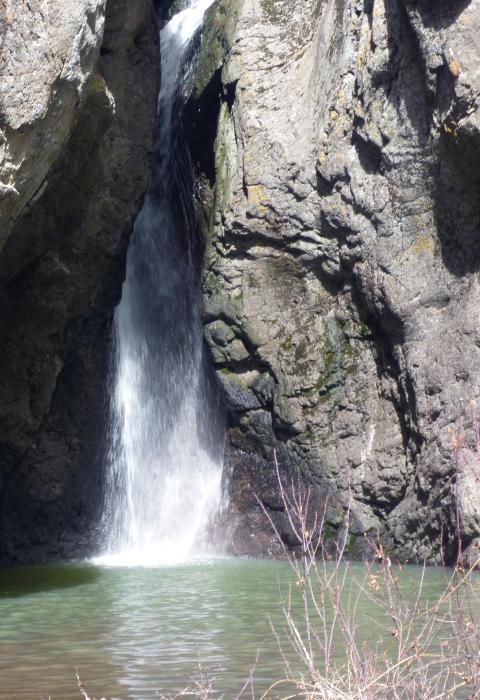Red Canyon
Idaho
Red Canyon flows south, and the stream cuts a narrow, deep gorge through the rolling plateau landscape on its way to the Owyhee River. Like the other canyons of the Owyhee River system, Red Canyon contains basalt and rhyolite walls. The canyon provides outstanding hiking and backpacking opportunities.
Designated Reach
March 30, 2009. Red Canyon from its confluence with the Owyhee River to the upstream boundary of the Owyhee River Wilderness.
Outstandingly Remarkable Values
Fish
Red Canyon supports sensitive redband trout populations; however, warmer summer water temperatures are insufficient to support productive redband fisheries. Seasonal migration of smallmouth bass into the Owyhee River system over the past several decades suggests that conditions may favor the development of a cool water fishery. However, the arrival of smallmouth bass would like initiate competition for food and space between bass and trout.
Geology
Red Canyon is part of the Owyhee, Bruneau, and Jarbidge river systems, home to the largest concentration of sheer-walled rhyolite/basalt canyons in the western United States, products of Miocene Era (23 to 5 million years ago) volcanic formations. Where overlying basalt is present, rhyolite (rock which began as lava flow) formations are nestled in the rubble slopes below vertical walls of basalt. Weathering and erosion have carved monolithic cliffs and numerous sculptured pinnacles known as “hoodoos.” The presence of these geologic formations in such great abundance and expansiveness make Red Canyon, the nearby Owyhee River, and other Owyhee tributaries geologically unique.
Recreation
High-quality day-hiking opportunities are available, especially during low-water periods. The remoteness provides exceptional opportunities for solitude, wildlife viewing, and photography.
Scenery
Landscape forms throughout the Owyhee Canyonlands vary from broad, open sagebrush steppes to narrow canyons, some exceeding 800 feet in depth. The canyons are dominated by a mixture of high, vertical lines and forms of coarse-textured, red, brown, or blackish eroded cliffs, often glazed with yellow to light green micro-flora. Intertwined with the vertical features are some very steep diagonal lines that frame triangular forms associated with talus slopes. The slopes have a mosaic of medium-textured, yellow and subdued green sagebrush-bunchgrass communities and/or dark green juniper, as well as either medium-textured, reddish rhyolite rubble fields or coarse-textured, blackish basalt rubble fields.
Spring rains support medium-textured, rich, green riparian vegetation along streams that run brownish in high flows amidst both large boulder-strewn rapids and calm reaches. During summer months, sparkling pools and slow-moving water tinted with green and brown channel colors reflect blue sky and a blend of forms, colors, and lines from surrounding cliffs and steep slopes.
The landscapes found in Red Canyon and throughout the designated Owyhee, Bruneau, and Jarbidge segments—combining line, form, color, and texture found amidst close associations of landforms, water, and vegetation—are among the best representations of basalt and rhyolite canyon/riparian associations in the region.
Wildlife
Big game commonly found in the area include elk, mule deer, and pronghorn, and the area’s steep cliffs and alcoves along the canyons provide key critical lambing and escape habitat for bighorn sheep. Red Canyon, in combination with the Owyhee River, Battle Creek, Deep Creek, Duncan Creek, and Wickahoney Creek, support the majority of the bighorn sheep population in the Owyhee Canyonlands.
Red Canyon offers Preliminary Priority Habitat for the greater sage-grouse. Other sensitive species include bald eagle, yellow-billed cuckoo, prairie falcon, ferruginous hawk, several neotropical migratory bird species, several bat species, Columbia spotted frog, and western toad. Cliffs also support spotted and Townsend’s big-eared bats, both Idaho BLM sensitive species.
Common large and mid-sized predators in the area include cougars, bobcats, coyotes, badgers, and raccoons. Small mammals include rodents, rabbits, shrews, weasels, and skunks. The waters along the entire Owyhee River system and its tributaries are considered outstanding habitat for river otters.
Birds in the area also include songbirds, waterfowl, shorebirds, and raptors. The high, well-fractured and eroded canyon cliffs are considered outstanding habitat for cliff nesting raptors, a small number of which occasionally winter along the canyon walls of the upper Owyhee River system and its major tributaries.
Other wildlife includes several species of reptiles (snakes and lizards) and amphibian (frogs, toads, and salamanders).

